The Blue Snowball Nebula is a bright planetary nebula located approximately 5,730 light-years away in the constellation Andromeda. With an apparent magnitude of 8.3 and an apparent size of 32 by 28 arcseconds, the nebula can be seen in amateur telescopes. It is catalogued as NGC 7662 in the New General Catalogue and Caldwell 22 in the Caldwell catalogue.
The Blue Snowball has a radius of about 0.8 light-years. It appears as a small but bright annular nebula and can be spotted even in small telescopes. The nebula has an elongated, elliptical shape and a bright inner shell. The distinctive blue colour makes it a popular target for amateur astronomers and astrophotographers.
Like all planetary nebulae, the Blue Snowball Nebula formed when an aging star exhausted its supply of hydrogen fuel and began to fuse heavier elements. As the fusion started to generate less energy, the stellar core was compressed by gravity and became hotter. The high temperature of the core caused the star’s outer layers to expand and the star evolved into a red giant.
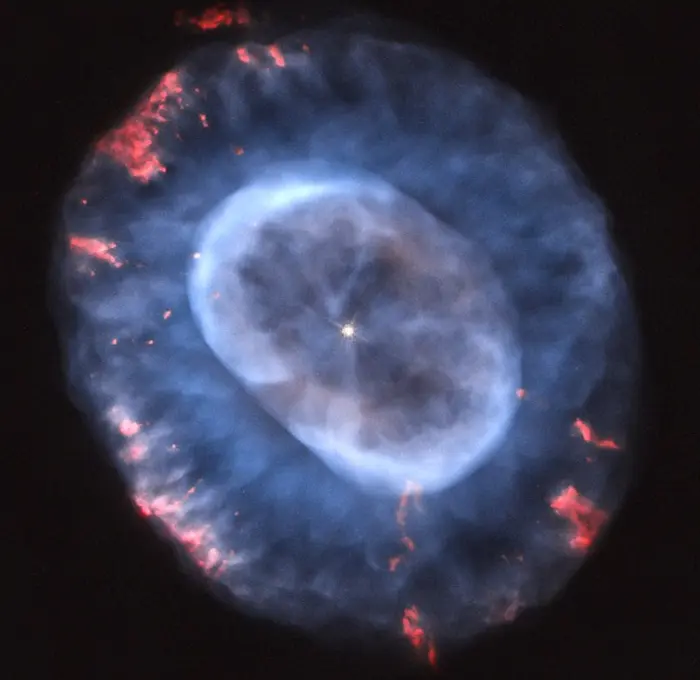
Caldwell 22, also cataloged as NGC 7662 and nicknamed the Snowball Nebula or Blue Snowball Nebula, is a planetary nebula located about 2,500 light-years from Earth. Nebulas like these represent a stage in evolution that stars like our Sun undergo when they run out of fuel. Stars are nuclear furnaces that spend most of their lives fusing hydrogen into helium. Massive stars have fiery fates, going out as supernovae, but medium-mass stars like the Sun swell to become red giants as they exhaust their fuel. The process begins when, after billions of years of nuclear fusion, the star starts to shut down. Gravity (no longer balanced by the outward pressure created by nuclear fusion) compresses the stellar core. The star’s outer layers of gas puff away into space, creating a planetary nebula (so named because these objects often resemble planetary orbs when viewed through a small telescope). At the center lie the remains of the original star’s compressed core, a small white dwarf. One day the Sun will meet a similar fate, but it has enough fuel to last another 6 billion years or so. Image credit: NASA, ESA and A. Hajian (University of Waterloo) (CC BY 2.0)
Evolved red giant stars lose a lot of mass – as much as 50 to 70 percent of their initial mass – through a powerful stellar wind. They keep venting their atmospheres into space, and the surface of the exposed stellar cores eventually becomes hot enough (>30,000 K) to ionize the expelled material. The clouds of gas then begin to glow as planetary nebulae.
The Blue Snowball Nebula has an estimated age of 3,080 years. The nebula’s main shell has an angular size of 12 by 18 arcseconds. The bright central ring of gas is enveloped by a dimmer elliptical shell. A faint, round halo surrounds both shells and stretches 134 arcseconds across.
The central star of NGC 7662 is catalogued as HD 220733. It is a subdwarf O star with the stellar classification of sdO. Subdwarf O stars are believed to have a carbon-oxygen core surrounded by a helium-fusing shell. They are exceptionally hot stars but appear much fainter than O-type stars that are still on the main sequence because they are not as massive.
Modelling yielded a surface temperature of 100,000 K for HD 220733, with only 60.5% of the Sun’s mass and 5,250 times the Sun’s luminosity. The star’s strong stellar wind colliding with previously expelled material produces X-ray emissions.
The nebula’s striking blue colour in long-exposure images comes from ionised helium, while the red portions come from ionised nitrogen. The latter are composed of material ejected from the central star in an earlier evolutionary phase.
The bright patches appearing on either side of the nebula are known as Fast Low-Ionization Emission Regions (FLIERS). FLIERS commonly appear near the symmetry axis of planetary nebulae. They are regions of gas with low ionization that move at supersonic speeds.
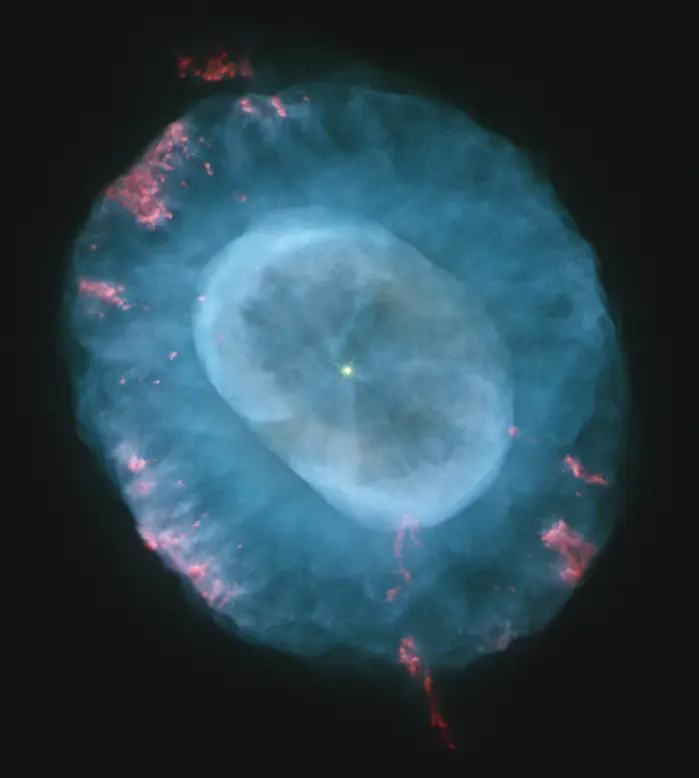
Blue Snowball Nebula by the Hubble Space Telescope (HST), credit: Judy Schmidt (CC BY 2.0)
Facts
The Blue Snowball Nebula was discovered by the German-born British astronomer William Herschel on October 6, 1784.
NGC 7662 was named the Blue Snowball by the American science fiction author and amateur astronomer Leland S. Copeland. In 1960, Copeland compared the nebula to a blue snowball in the February issue of Sky & Telescope magazine. The nebula is sometimes also called Copeland’s Blue Snowball.
English amateur astronomer Sir Patrick Moore included NGC 7662 as Caldwell 22 in his Caldwell catalogue of deep sky objects visible in amateur telescopes.
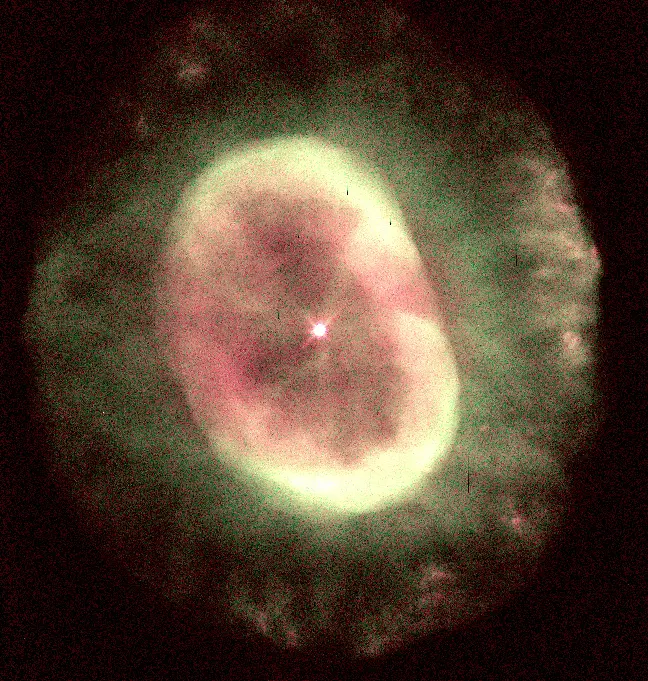
A 1997 Hubble Space Telescope (HST) image of NGC 7662. Image credit: Howard Bond (STScI) and NASA/ESA (PD)
Several other planetary nebulae have a similar appearance to the Blue Snowball. These include NGC 2022 in the constellation Orion (mag. 11.6), the Clown-faced Nebula (NGC 2392) in Gemini (mag. 10.1), the Blinking Planetary Nebula (NGC 6826) in Cygnus, and the Ghost of Jupiter (NGC 3242) in Hydra (mag. 8.60).
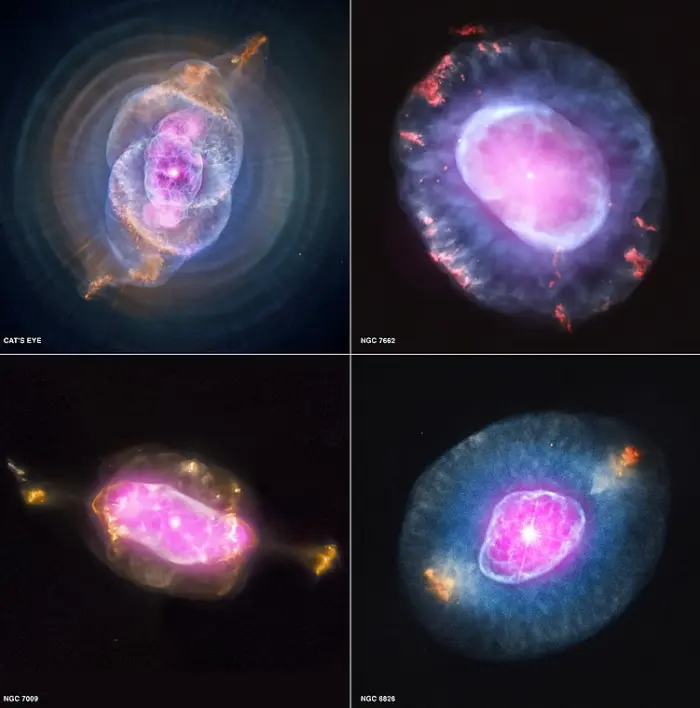
This gallery shows four planetary nebulae from the first systematic survey of such objects in the solar neighborhood made with NASA’s Chandra X-ray Observatory. The planetary nebulae shown here are NGC 6543 (aka the Cat’s Eye Nebula), NGC 7662 (the Blue Snowball Nebula), NGC 7009 (the Saturn Nebula) and NGC 6826 (the Blinking Planetary Nebula). X-ray emission from Chandra is colored purple and optical emission from the Hubble Space Telescope is colored red, green and blue. A planetary nebula is a phase of stellar evolution that the Sun should experience several billion years from now, when it expands to become a red giant and then sheds most of its outer layers, leaving behind a hot core that contracts to form a dense white dwarf star. A wind from the hot core rams into the ejected atmosphere, creating the shell-like filamentary structures seen with optical telescopes. The diffuse X-ray emission is caused by shock waves as the wind collides with the ejected atmosphere. The properties of the X-ray point sources in the center of about half of the planetary nebulae suggest that many central stars responsible for ejecting planetary nebulae have companion stars. Credit – X-ray: NASA/CXC/RIT/J.Kastner et al.; Optical: NASA/STScI (PD)
Location
The Blue Snowball Nebula lies in the region between two bright, prominent asterisms, Cassiopeia’s W and the Great Square of Pegasus. The nebula appears a little more than halfway from Caph in Cassiopeia to Scheat in Pegasus.
NGC 7662 lies in the same area as an asterism known as Frederick’s Glory. The asterism is formed by Iota Andromedae, Kappa Andromedae, Lambda Andromedae, and Psi Andromedae. These were the brightest stars in the obsolete constellation Honores Friderici (or Gloria Frederici).
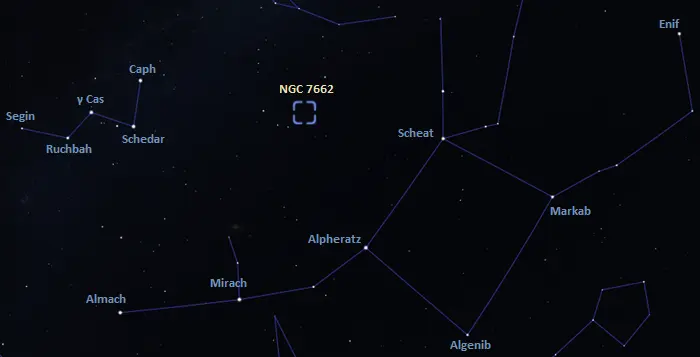
The location of the Blue Snowball Nebula (NGC 7662), image: Stellarium
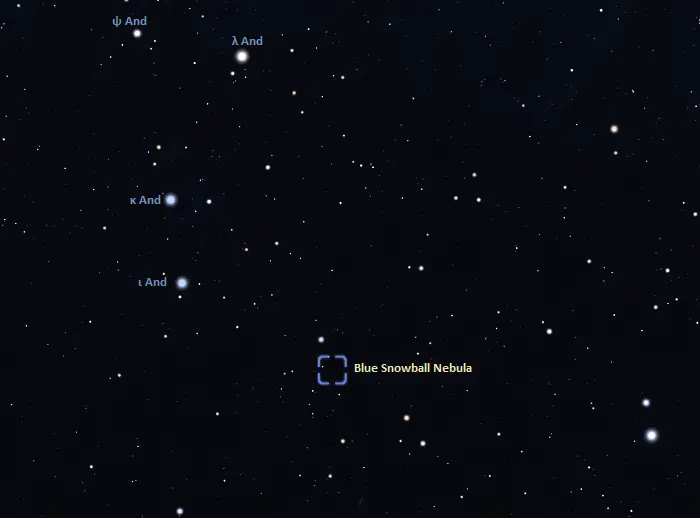
The Blue Snowball Nebula and Frederick’s Glory, image: Stellarium
In small telescopes, the Blue Snowball appears like a fuzzy star surrounded by faint nebulosity. The main shell has a high surface brightness and may even be spotted in binoculars. The nebula’s blue disk can be seen in 6-inch and larger telescopes at high magnification. The details of the inner portion of the nebula may be spotted in 16-inch and larger instruments.
The Blue Snowball is best seen with O-III filters. The dim central star is only visible in large telescopes. At declination +42° 32′, NGC 7662 is visible from locations north of the latitude 46-47° S.
The best time of the year to observe the Blue Snowball Nebula and other deep sky objects in Andromeda is during the month of November, when the constellation appears high above the horizon in the early evening. Observers in the northern hemisphere can see Andromeda for most of the year at some point in the night.
Blue Snowball Nebula – NGC 7662
| Constellation | Andromeda |
| Object type | Planetary nebula |
| Right ascension | 23h 25m 53.8318792825s |
| Declination | +42° 32′ 05.835828380″ |
| Apparent magnitude | 8.3 |
| Apparent size | 32″ × 28″ |
| Distance | 5,730 ± 340 light-years (1,757 ± 104 parsecs) |
| Radius | 0.8 light-years |
| Names and designations | Blue Snowball Nebula, Copeland’s Snowball Nebula, Snowball Nebula, NGC 7662, Caldwell 22, PK 106-17 1, PN G106.5-17.6, PN ARO 20, VV 285, VV’ 575, GCRV 14695, HD 220733, AG+42 2277, BD+41 4773, LEDA 165926, IRAS 23234+4215, PLX 5676.00, NSV 14555, NVSS J232553+423205, PPM 64213, UCAC4 663-118248, WEB 20468, BWE 2323+4215, TXS 2323+422, WISE J232553.92+423205.8, WN B2323.4+4215, Gaia DR3 1924818288379268736 |